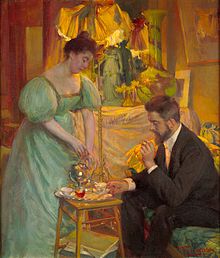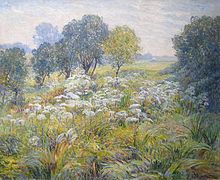Juliette Wytsman
Juliette Wytsman , b. Trullemans (born July 14, 1866 in Brussels , † March 8, 1925 in Ixelles ) was a Belgian landscape painter . She is considered to be one of the most important representatives of Belgian impressionism from the late 19th to early 20th century.
Life
Juliette Trullemans was born in Brussels as the daughter of Emmanuel Trullemans and Julie Trullemans. She received her artistic training at the private École professional Bischoffsheim in Brussels. Since women were not admitted to study at the art academy, she was trained in painting , ceramics , batik and embroidery by Henri Hendrickx . The motifs of her first works mainly showed floral still lifes in the style of realism . At the École Bischoffsheim she made the acquaintance of Ketty Hoppe , who later became the wife of Victor Gilsoul .
Juliette Trullemans perfected her painting technique with the painter Jean Capeinick (1838–1890) , who came from Ghent . Her works at this time are heavily influenced by Capeinick. She made her debut at the art salon in 1883 with a realistic flower arrangement - a geranium plant in a simple clay pot. Juliette Trullemans met Rodolphe Wytsman in Capeinick's studio , whom she married on February 16, 1886. The couple initially lived in the Leopold Quarter in Brussels and moved to Ixelles at Keyenveldstraat 39 in 1900.
The couple devoted themselves to outdoor painting . He created numerous paintings of landscapes in Brabant , Bruges , in the area around Knokke and in the Meuse valley as well as of plants and still lifes. Near the Sonian Forest , in Terhulpen , the artist couple owned a country house that was used as a starting point for numerous drawing excursions. In 1905, her picture Lilies in a country house garden near Bruges was included in the book Women Painters of the World published by Walther Shaw Sparrow.
The Wytsmann couple were an integral part of the Brussels artist community around the writer and art critic Camille Lemonnier , the sculptor Charles van der Nahrungsmittel and the painter Emile Claus . Influenced by the Impressionist painters of her time, Juliette Wytsman increasingly devoted herself to this drawing style. During this creative period, her work focused on the visual representation of the effects of intense light in the interplay of colors and shapes. Juliette Wytsman, along with her husband, Emile Claus, Jenny Montigny , Anna De Weert , Gustave de Smet and Frits van den Berghe, was one of the most important representatives of luminism in Belgian painting. Occasionally Juliette Wytsman also made etchings . One of her works has been published in the book Notre Pays on the occasion of the 75th anniversary of the founding of Belgium . The proceeds from their paintings enabled the couple to achieve economic independence. You made numerous trips to other European countries. Some drawings have survived from her trip to Austria (1913) and Tenerife (1914).
As early as 1892, the couple acquired the Les Tournesols (The Sunflowers) property in the Brussels suburb of Linkebeek, with a large flower garden that was also shown in numerous paintings. Together with Anna Boch , Alice and Emma Ronner, Louise and Marie Danse, Berthe Art and Ketty Gilsoul-Hoppe, Juliette Wytsman founded the Lyceum gallery in Brussels in 1911 .
After the outbreak of World War I in August 1914, the couple fled Belgium to Rotterdam . In the Netherlands , with the help of exhibitions in the Rotterdam Art Society , they supported other Belgian emigrants with great commitment, including Gustav de Smet, Fritz van den Berghe, Rik Wouters , Walter Vaes, Joseph Cantré, William Degouve de Nunques, Frans Smeers, William Paerels, Georges van Tongerloo and Edith van Leckwijck. The couple had a particularly close friendship with Rik Wouters. When the young artist died in Amsterdam in 1916 , Juliette's husband gave the funeral oration. During her emigration , Juliette drew landscape motifs in the vicinity of Oisterwijk , Plasmolen , Delfshaven and Mook . In November 1916, the Stedelijk Museum in Amsterdam hosted an exhibition on modern Belgian art. Rodolphe Wytsman was on the organizing committee for this exhibition.
After the war, Juliette returned to Lintebeek with her husband and largely withdrew from public artistic life. Shortly before her death, she and her husband prepared a double retrospective . She died on March 8, 1925 at her home in Ixelles. Her husband survived her for two years.
In addition to painting, Juliette Wytsman also devoted herself to bookbinding . Her artistic Art Nouveau work received a lot of attention. For the writer Camille Lemonnier she also created the illustrations for his novel Le Sang et les Roses . She taught students at the École Bischoffsheim and École Fernand Cocq not only in painting, but also in the art of bookbinding. Her students also included members of the Belgian royal family.
Appreciations and reception
For her services, Juliette Wytsman was appointed Officier de l ' Ordre de la Couronne and Chevalier (Knight) de l' Ordre de Léopold .
Charles Samuel made a marble bust of Juliette Wytsman in 1893, which is now in the Royal Museums of Fine Arts of Belgium in Brussels. In the Brussels district of Ixelles, a street was named after the artist in her honor. Juliette Wytsman's works are currently regularly generating five-figure sales at renowned auctions.
Exhibitions and museums
During her lifetime, Juliette Wytsman took part in various exhibitions and art salons a. a. in Paris, Munich, Berlin, Dresden and Chicago. Today her works are shown particularly in Belgian museums:
- Antwerp , Royal Museum of Fine Arts .
- Brussels, Royal Museums of Fine Arts of Belgium
- Brussels, Royal Library of Belgium (bindings)
- Brussels, Musée Camille Lemonnier
- Ixelles / Brussels, Ixelles Museum
- Sint-Jans-Molenbeek / Brussels, Collezioni
- Sint-Joost-ten-Node , Museum Charlier
- Ghent , Museum of Fine Arts
- Liège , Musee d'Art Wallon
- Ostend , Kunstmuseum aan Zee
Works (selection)
- Les dames elegantes , 1881
- Bouquet de fleurs , 1883
- Jardin d'été c.1890
- Les pivoines , 1895
- Fleurs d'automne en Brabant , 1895–1899
- La bruyère rose , 1899
- Coin d'étang - La mare le matin , 1906
- Foret de Soignies , 1906
- Printemps , 1907
- Eté en Mentelberg (Innsbruck), 1913
- Santa Cruz de Tenerife , 1914
- Coquelicots
- Roses trémières
- La mare
- Jardin fleuri près de la ferme
- Chrysanthemums roses
- Les genêts
- Ferme fleurie
- Champ de coquelicots
- Cerisiers en fleurs
- Pommiers en fleurs
- Nature morte aux roses et oeillets
- Danseuse au tambourine
- Les tournesols sous la neige
- Cour d'hospice à Bruges
- Le jardin fleuri
- Le Potager
- Spireen
- Briar rose
Individual evidence
- ^ A b c E. Gubin: Dictionnaire de femmes belges: XIXe et XX siècles , Lannoo Uitgeverij, Edition racine, Brussels 2006, ISBN 2-87386-434-6 , p. 530f.
- ↑ Women Painters of the World - From the time of Catarina Vigri (1413-1463) to Rosa Bonheur and the present day. In: Walter Shaw Sparrow (Ed.): The Art and Life Library . tape 3 . Hodder & Stoughton, London 1905, pp. 284 .
- ↑ belart.org: Juliette Wytsman , accessed August 29, 2015
- ↑ Fr. Schauwers: Reliures exécutées par Juliette Wytman et éditions dʹart de la bibliothèque de celle-ci- Ministère de lʹinstruction publique . Catalog, Bibliothèque Royale de Belgique, Bruxelles 1936, 26 pp.
- ↑ fine-arts-museum.be Charles Samuel: Juliette Wytsman , accessed on August 29, 2015
- ↑ charliermuseum.be: Juliette Wytsman retrieved on August 26, 2015
literature
- L. Jottrand: Juliette Wytsman: 1860-1925. Ferain, Brussels 1926, 32 pp.
- Reliures exécutées par Juliette Wytsman et éditions d'art de la bibliothèque de celle-ci, May - 7 June 1936 . Leherte-Delcour, Brussels 1936, 26 pp.
- O. Roelandts: Juliette Wytsman. In: Biographie Nationale de Belgique Volume 27, Brussels 1938.
- P. and V. Berko: Dictionnaire des peintres belges nés entre 1750 et 1875. Brussels-Knokke, 1981.
- WG Flippo: Lexicon of the Belgian Romantic Painters. , Antwerp 1981.
- S. Goyens de Heusch: Het impressionisme en het fauvisme in België (tentoonstellingscat.) , Elsene (Museum van Elsene), 1990.
- N. Hostyn: Juliette Trullemans. In: Nationaal Biografisch Woordenboek Volume 13, Brussels 1990.
- G. Czymmek (Ed.): Landscape in the light, impressionist painting in Europe and North America, 1860-1910. Exhibition catalog Wallraf-Richartz-Museum Cologne and Kunsthaus Zürich. 1990.
- Koninklijke Academiën van België (ed.): Trullemans, Juliette . Nationaal Biografisch Woordenboek 13, 1990, pp. 785-788
- N. Hostyn: Rodolphe Wytsman, Juliette Wytsman: Catalog, Editions Gallery Luc Pieters, Knokke 1997, 34 pp.
- P. Piron: De Belgische beeldende kunstenaars uit de 19de en 20ste eeuw , 2nd edition, Brussels 1999.
- W. and G. Pas: Biographical Lexicon Plastic Art in België. Schilders- beeldhouwers-grafici 1830-2000 . Antwerp 2000. * Koninklijk Museum voor Schone Kunsten (Ed.): Vrouwelijke kunstenaars in België en Nederland 1500-1950 . Catalog, Antwerp 2000, p. 290
- G. Dugnat: Les catalogs des Salons de la Société Nationale des Beaux-Arts. II (1896-1900). Dijon 2001.
- W. and G. Pas: Dictionnaire biographique arts plastiques en Belgique. Peintres-sculpteurs-graveurs 1800-2002 , Antwerp 2002.
- P. Piron: Dictionnaire des artistes plasticiens de Belgique des XIXe et XXe siècles. Lasne, 2003.
- Joost De Geest: 500 chefs-d'oeuvre de l'art belge. Lannoo Uitgeverij, Brussels 2006, ISBN 978-2-87386-470-5 , p. 507
- E. Gubin: Dictionnaire de femmes belges: XIXe et XX siècles , Lannoo Uitgeverij, Edition racine, Brussels 2006, ISBN 2-87386-434-6 , pp. 530f.
- Wytsman, Juliette . In: Hans Vollmer (Hrsg.): General lexicon of fine artists from antiquity to the present . Founded by Ulrich Thieme and Felix Becker . tape 36 : Wilhelmy-Zyzywi . EA Seemann, Leipzig 1947, p. 339-340 .
Web links
| personal data | |
|---|---|
| SURNAME | Wytsman, Juliette |
| ALTERNATIVE NAMES | Trullemans, Juliette Henriette (maiden name); Juliette Wijtsman; Juliette Trullemans |
| BRIEF DESCRIPTION | Belgian painter |
| DATE OF BIRTH | July 14, 1866 |
| PLACE OF BIRTH | Brussels |
| DATE OF DEATH | March 8, 1925 |
| Place of death | Ixelles |



